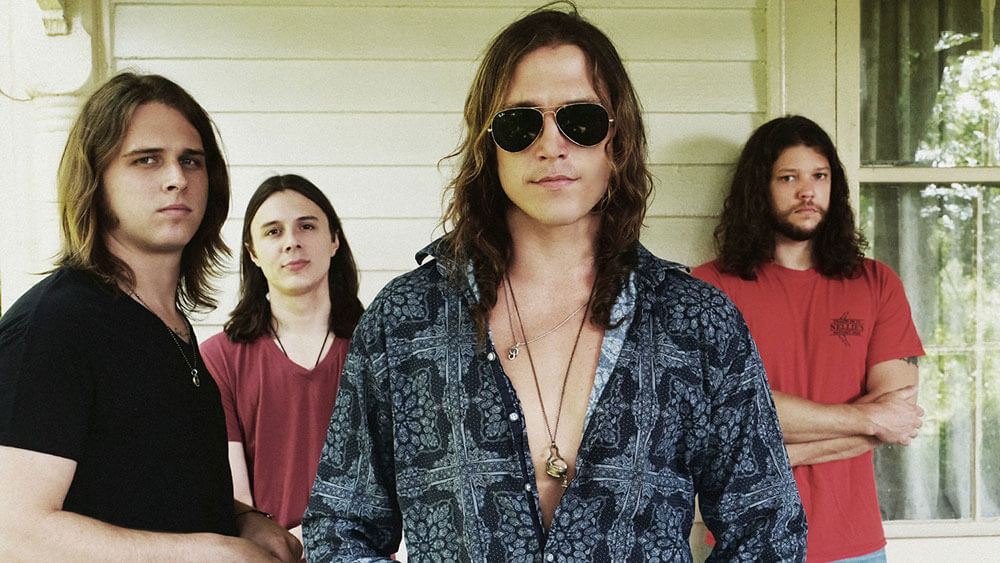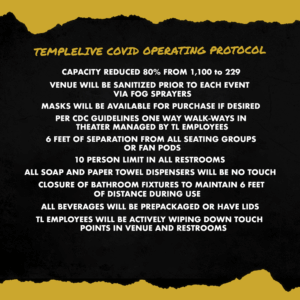
Travis McCready (blue shirt) of the band Bishop Gunn played a “socially distant” concert without his bandmates at TempleLive in Fort Smith, Arkansas. (Courtesy Farm2Turntable)
As COVID-19 continues to force postponements, cancellations, and closings, business event professionals have been trying to answer a tough question: What will bringing people together — while keeping them six feet apart — look like? Some members of the PCMA community are pondering large aisles and tape markers. Other companies are designing hazmat-style suits and hiring robots to simulate a crowd. While conferences have yet to make a return in the U.S., another kind of event held May 18 — the first socially distant concert in a music venue — offers a peek at what business gatherings may look like in the near future.
The show, at TempleLive in Fort Smith, Arkansas, almost didn’t happen. When the venue announced a show with Travis McCready of the band Bishop Gunn, the Arkansas Department of Health issued a cease-and-desist order and revoked the venue’s liquor license. Mike Brown, vice president of the venue, made adjustments to adhere to the Department of Health’s guidelines, reducing the venue’s capacity from 1,100 to 229, sanitizing the facility with fog sprayers, limiting restroom capacity to 10 individuals at a time, and taking a range of other steps.
“This is about rock and roll and having a good time and doing what you do as an American,” Brown said in an interview with NBC 5 News. “You get out. You do things.”

TempleLive posted its COVID-19 operating restrictions on its Facebook page.
Getting out, however, meant putting on a face mask, getting a temperature check prior to entry, and taking your spot in some awkward seating configurations called “fan pods.” Lauren Brown, the opening act for the evening, described them as “a block of seats… for you and your family or people that you’ve been quarantining with.”
Footage from inside the venue (see video at bottom) revealed a sparse crowd — a far cry from the traditional rush of fans standing in front of a stage. That feeling was summed up well by Dave Grohl, lead singer of the Foo Fighters in The Atlantic earlier this month. “There is nothing like the energy and atmosphere of live music,” Grohl wrote. “It is the most life-affirming experience to see your favorite performer onstage, in the flesh, rather than as a one-dimensional image glowing in your lap as you spiral down a midnight YouTube wormhole.”
Grohl continued to offer his perspective — not just a performer — on what makes being part of a crowd meaningful. “As a lifelong concertgoer, I know this feeling well,” he wrote. “I myself have been pressed against the cold front rail of an arena rock show. I have air-drummed along to my favorite songs in the rafters, and been crushed in the crowd, dancing to dangerous decibel levels while lost in the rhythm. I’ve been lifted and carried to the stage by total strangers for a glorious swan dive back into their sweaty embrace. Arm in arm, I have sung at the top of my lungs with people I may never see again. All to celebrate and share the tangible, communal power of music.”
There is no opportunity to crowd surf or to share arms with strangers in an environment like TempleLive — or at drive-in concerts like the secret one Keith Urban performed May 14 for health-care workers. And while crowd surfing is not a typical business event activity, experiencing a sense of community is. Some in-person events are returning and trying — despite a host of health protocols — to regain that sense of togetherness. The MBC Architecture Show, for example, united more than 45,000 participants May 10-13 in South Korea.
David McMillin is an associate editor at Convene.
A snapshot of the socially distanced Travis McCready show tonight: pic.twitter.com/OlHJbDzT9K
— Times Record (@TimesRecord) May 19, 2020
